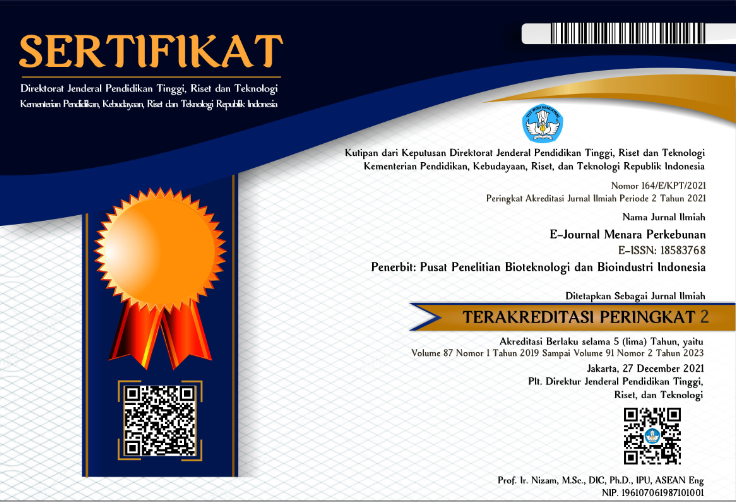Potensi masak tebang lima tipe sagu (Metroxylon sagu Rottb.) di kawasan hutan sagu Sentani, Papua Mature palm potency of five types of sago (Metroxylon sagu Rottb.) at sago forest area of Sentani, Papua
DOI:
https://doi.org/10.22302/iribb.jur.mp.v82i1.26Keywords:
sago type, sago cluster, trunk productivityAbstract
Abstract
Sago palm (Metroxylon sagu Rottb.) is one of the most potential starch-producing crops, however its utilization has not yet optimal, only around 10%, and mostly from sago trees grown near the villages. The objective of this research was to collect data of the potentially productive trees which are Mid Trunk (MT) and Mature Palm (MP) at sago forest of Sentani, Papua province. Survey method was used for this research by making inventory tracks into three plots as subpopulation and three inventory tracks in every plot with 100 m length and 50 m width, and the distance between tracks was 150 m to find out the spreading and approximation of potential trees through multistage analysis. The observed parameters were number of cluster, number of MT and MP for every types of sago palm. The results show that there were three intra-species of spiny sago palms called Yakari, Bata, and Dondo, and two intra-species of unspiny sago palms called Yebha and Ojokuru. The dominant sago type was Yebha. The cluster was spreading sporadically with coefficient of variance (CV) at 24.3, The predicted number of MT was higher than MP. Numbers of MT and MP for every hectare of sago forest were very low, 1.3 MT/ha and 0.3 MP/ha
Abstrak
Tanaman sagu (Metroxylon sagu Rottb.) merupakan tanaman penghasil karbohidrat yang sangat potensial, namun pemanfaataannya masih belum optimal, yaitu hanya sekitar 10%, dan sebagian besar merupakan tanaman sagu yang tumbuh di sekitar perkampungan. Tujuan dari peneli-tian ini adalah mendapatkan data pohon yang berpotensi produktif yaitu pohon Belum Masak Tebang (BMT) dan pohon Masak Tebang (MT) di kawasan hutan sagu Sentani, provinsi Papua. Metode survai digunakan pada penelitian ini dengan membuat jalur-jalur inventarisasi dalam tiga plot sebagai sub-populasi dan tiga jalur inventarisasi di setiap plot dengan panjang jalur 100 m, lebar jalur 50 m dan jarak antar jalur 150 m untuk mengetahui tebaran dan penaksiran potensi pohon melalui analisis multi tahap. Parameter yang diamati adalah jumlah rumpun, pohon BMT dan MT untuk setiap jenis sagu. Hasil yang diperoleh: menunjukkan bahwa terdapat tiga spesies sagu berduri yaitu, Yakari, Bata, Dondo dan dua spesies sagu tidak berduri yaitu:Yeba dan Ojokuru. Jenis yang mendominasi adalah Yebha. Terlihat adanya tebaran rumpun yang sporadis dengan koefisien keragaman (CV) =24,30, dengan jumlah pohon BMT yang lebih tinggi dibandingkan pohon MT. Hasil penaksiran menunjukkan bahwa jumlah pohon per hektar sangat rendah berturut-turut BMT 1,3 pohon/ha dan MT 0,3 pohon per ha
.
Downloads
Downloads
Submitted
Accepted
Published
How to Cite
Issue
Section
License
Authors retain copyright and grant the journal right of first publication with the work simultaneously licensed under a Creative Commons Attribution License that allows others to share the work with an acknowledgement of the work's authorship and initial publication in this journal.













